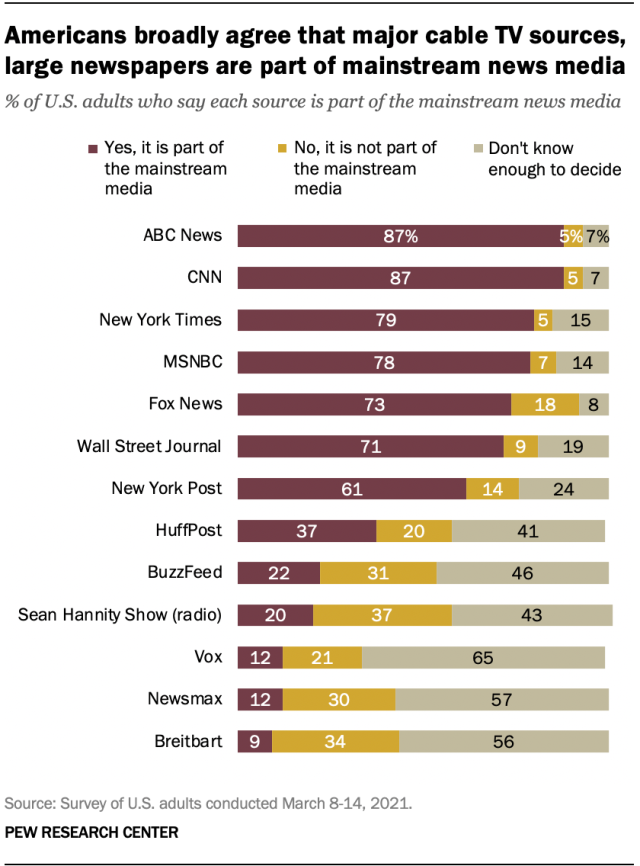
The New York Post serves as the USA’s oldest continuously-published news, dating back to the 1800s. While its content is distributed and consumed worldwide, the NY Post ranks 14th among news and media sources with an average of 127 million monthly visits. Yet, headlining articles state that the New York Post is the least credible major news source in the city. As this blog will investigate, is the NY Post as unreliable as these headlines claim?
Does Reliability Matter?
Reliability, in general, refers to how trustworthy or accurate information, or in this case, a news source is. If we consider this definition, it quickly becomes clear why reliability is important in media sources. If we can’t trust the things we read then there isn’t much of a point in continuing to consume content from that source, after all. So how exactly can we gauge the reliability of a news source anyways?
There are several potential measures of reliability to look out for when trying to determine whether a media source is reliable or not. Red flags for an unreliable article can include the presence of wild unsubstantiated claims, facts dependent on other unreliable sources, heavy use of opinionated language, and more. Some indicators of a reliable news source, on the other hand, include things like:
- Absence of subjective/opinionated language in articles
- Credible sources cited (e.g., neutral sources, .gov, .edu websites)
- Facts and statistics backed by multiple relevant outside sources
- Use of primary sources when possible (e.g., interviews, quotes)
- Information that remains consistent across news sources
Despite this, as Pew Research suggests, Americans agree that the NY Post is an example of mainstream news media. Take a look at this graph below, which shows that Americans agree that NY Post is comparable to other sources such as Wall Street Journal and Fox News:

Source: Pew Research Center
So Just How Reliable is the NY Post?
Using Biasly’s political analysis as well as their bias scores helps gives quantifiable data on how reliable the NY Post is. Analysts gave the NY Post a Reliability score of 90%. Third-party sources such as Media/Bias Fact Check give the NY Post “Medium Credibility” with limited information as to why they gave that credibility score.
While Biasly’s score represents the platform as a whole, it is imperative to recognize that articles will vary with higher or lower scores, depending on their author or topic. Consider also that the popular Wall Street Journal has a reliability score of 96%.
So what’s the difference between a reliable and an unreliable article? Well, political bias is the ultimate determinant of whether or not a news source is reliable. Examining the accuracy and political leanings of the NY Post will reveal the article’s reliability.
NY Post Accuracy and Reliability
With questions surrounding the NY Post’s reliability, there are many claims that the articles seek to push ideology rather than reporting specific facts. Assessing where NY Post finds itself on an ideological scale will show how it affects the accuracy and reliability of articles. Two additional yet important factors include screening for bias- specifically selection and omission bias.
Selection bias is when stories and facts are selected or deselected, often on ideological grounds, to create a narrative in support of the new sources’ ideology. Omission bias, on the other hand, is when different opinions and political views regarding a situation are left out so that the reader is only exposed to the ideological perspective supported by the author. It’s important to keep in mind these two types of biases when trying to assess an article’s level of accuracy.
Biasly rates accuracy on a percentage scale of 1-100, with 1 being the least accurate and 100 being the most accurate. These ratings are determined by measuring claims with factual reasoning, credible sources, and the number of credible external sources in an article. Between the five articles analyzed and rated, the reliability score was 90%. These dependability and accuracy ratings for newly released NY Post articles can be found here.
Taking a look at the articles analyzed on Biasly’s website, the reliability and accuracy scores vary from article to article, yet remain between the range of 73-100% reliability. Changes in reliability are due to changes in selection and omission bias and the quality of sources and facts used in the article, which varies from article to article.
Additionally, articles with a political leaning (also reflected on New York Post Media Bias page) are less reliable than neutral ones, simply because unbiased articles typically report using credible sources from both sides of the political spectrum and even find themselves avoiding the topic of political parties entirely,
For example, “Pentagon scrambles to implement new vaccination and testing mandates” is rated as 6% Moderate-right but is very close to the center. Concerning selection and omission bias, the article is straightforward and information-driven. Concise yet informative, the article contains all the information required to give context to the report.
It appears that no facts are selected or omitted based on the NY Post’s typical conservative stance. Moreover, there is no appearance of omission bias as the author remains neutral to deliver an informative article, shedding light on the Defense Department’s responsibilities:
“The Defense Department must develop plans to make the vaccine mandatory for the military while simultaneously creating plans to deal with new requirements for federal workers to show proof of vaccination, or face frequent testing.”
Author Eileen AJ Connolley remains neutral and uses credible sources such as the Pentagon and The Associated Press. So, this article is an example of a reliable piece that conveys information without omitting or being selective about sources and facts.
More examples will be looked at below, which will further look at the reliability of NY Post articles, including the use of selection bias, omission bias, and quality of sources and facts used.
Analysis of NY Post Opinion Articles
Opinion pieces, which are the complete opposite of objective reporting, convey a persuasive argument with lower accuracy rates and overall reliability. While the examples above demonstrate different levels of opinions and facts, opinion pieces seek to persuade readers to conform to the political beliefs of the author.
Despite being the oldest continuously-published news in the US, critics have claimed that the NY Post is the least credible major news source. Being a conservative tabloid, they typically promote anti-Biden agenda news which perhaps clouds the judgment of someone who wants to remain neutral on the political spectrum.
By examining the quality of sources and facts used and the selection and omission bias, the reliability of the NY Post will be further evaluated and explained.
Quality of Sources and Facts Used
The NY Post typically uses reliable sources from both sides of the political spectrum, meanwhile, sometimes that is not the case. For example, “Biden meets with Sen. Manchin as spending agenda hangs in balance” uses accurate sources but with a slight conservative lean.
Here, 11 quotes are used, with the majority of them from Senator Manchin via various sources. A list of these various sources is below:
- Additional NY Post articles
- Bloomberg News
- CNN
- West Virginia’s News outlet
- White House Press Secretary Jen Psaki
- Transportation Secretary Pete Buttigieg
While the plethora of quotes from the article from interviews from credible and quality sources such as Bloomberg News and CNN makes this article an easy read, the author continuously reverts back to their conservative beliefs as expressed by Manchin’s lack of comfortability with the size of Biden’s spending bills.
Yet, with the sources still swaying in favor of a conservative point of view, the article points in a conservative-leaning direction as there is a lack of left-supporting sources being used.
Selection and Omission Bias
In analyzing the NY Post’s opinion piece titled “Fellow Democrats, recognize how dangerous is an ambitious AOC” is an extremely conservative piece that has selection and omission bias throughout. There are only two short quotes in the entire article, including a dramatic opening line:
“Alexandra Ocasio-Cortez is one of the most polarizing and divisive figures in modern American politics.”
The opening statement of this article quickly clarifies the stance of the author’s disagreement with AOC’s values. Without fact-based or credible sources, the article continues to take digs at AOC’s character without citing any left-wing sources.
“What is perhaps most troubling about AOC is her willingness to disregard constitutional principles when they do not conform to her political or ideological agenda.”
While there is an initial bias from the opening line, this continues as the authors lead readers in a direction stating that AOC doesn’t follow constitutional principles that do not sustain her political or ideological agenda.
By omitting any facts or quotes from AOC’s political side, the authors are choosing to refuse to address the other side of the political spectrum’s beliefs. As a result, the article is framed in a way that only favors her opposition.
Only one point of view is displayed and is heavily pushed to readers, causing the overall reliability of the article to be questioned, as facts and points from the other side’s view limit the frame of discussion– both points of view are not represented. Thus, the reliability of opinion pieces, as seen in this example above, prevents the reader from making their own informed decision about AOC.
In opinion pieces such as that as seen above, there are often issues with factuality, sources, selection and commission bias. While we have seen a range of somewhat extremely biased articles and opinion pieces from the NY Post, this ultimately reinforces the range between reliable and unreliable articles from the same source.
So, is NY Post Reliable?
Just as articles differ between their content and authors, the NY Post on average has a decent reliability score of 90%. While this score varies from article to article and author to author, Biasly can analyze these bias and reliability scores using Biasly’s News Check Chrome extension.
Beyond this, it is important to have an improved understanding of bias and reliability in articles, especially as it varies between sources. By improving our media literacy, steps can be taken to improve the bias presented in media and help us as readers to develop a complete understanding of the text provided.


























